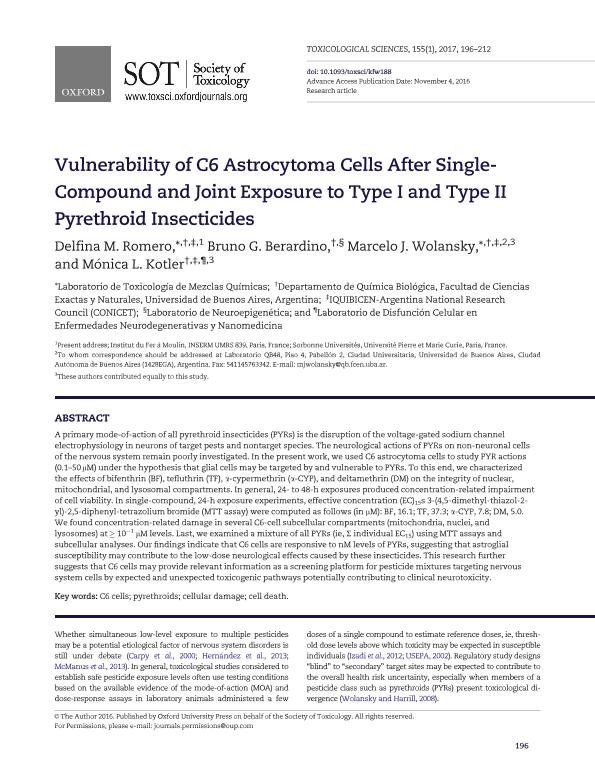Artículo
Vulnerability of C6 astrocytoma cells after single-compound and joint exposure to type I and type II pyrethroid insecticides
Romero, Delfina Mercedes ; Berardino, Bruno Gabriel
; Berardino, Bruno Gabriel ; Wolansky, Marcelo Javier
; Wolansky, Marcelo Javier ; Kotler, Monica Lidia
; Kotler, Monica Lidia
 ; Berardino, Bruno Gabriel
; Berardino, Bruno Gabriel ; Wolansky, Marcelo Javier
; Wolansky, Marcelo Javier ; Kotler, Monica Lidia
; Kotler, Monica Lidia
Fecha de publicación:
09/2017
Editorial:
Oxford University Press
Revista:
Toxicological Sciences
ISSN:
1096-6080
Idioma:
Inglés
Tipo de recurso:
Artículo publicado
Clasificación temática:
Resumen
A primary mode-of-action of all pyrethroid insecticides (PYRs) is the disruption of the voltage-gated sodium channel electrophysiology in neurons of target pests and nontarget species. The neurological actions of PYRs on non-neuronal cells of the nervous system remain poorly investigated. In the present work, we used C6 astrocytoma cells to study PYR actions (0.1-50 μM) under the hypothesis that glial cells may be targeted by and vulnerable to PYRs. To this end, we characterized the effects of bifenthrin (BF), tefluthrin (TF), α-cypermethrin (α-CYP), and deltamethrin (DM) on the integrity of nuclear, mitochondrial, and lysosomal compartments. In general, 24- to 48-h exposures produced concentration-related impairment of cell viability. In single-compound, 24-h exposure experiments, effective concentration (EC)15s 3-(4,5-dimethyl-thiazol-2- yl)-2,5-diphenyl-tetrazolium bromide (MTT assay) were computed as follows (in μM): BF, 16.1; TF, 37.3; α-CYP, 7.8; DM, 5.0. We found concentration-related damage in several C6-cell subcellular compartments (mitochondria, nuclei, and lysosomes) at≥ 10-1 lM levels. Last, we examined a mixture of all PYRs (ie, Σ individual EC15) using MTT assays and subcellular analyses. Our findings indicate that C6 cells are responsive to nM levels of PYRs, suggesting that astroglial susceptibility may contribute to the low-dose neurological effects caused by these insecticides. This research further suggests that C6 cells may provide relevant information as a screening platform for pesticide mixtures targeting nervous system cells by expected and unexpected toxicogenic pathways potentially contributing to clinical neurotoxicity.
Palabras clave:
C6 CELLS
,
CELL DEATH
,
CELLULAR DAMAGE
,
PYRETHROIDS
Archivos asociados
Licencia
Identificadores
Colecciones
Articulos(IQUIBICEN)
Articulos de INSTITUTO DE QUIMICA BIOLOGICA DE LA FACULTAD DE CS. EXACTAS Y NATURALES
Articulos de INSTITUTO DE QUIMICA BIOLOGICA DE LA FACULTAD DE CS. EXACTAS Y NATURALES
Citación
Romero, Delfina Mercedes; Berardino, Bruno Gabriel; Wolansky, Marcelo Javier; Kotler, Monica Lidia; Vulnerability of C6 astrocytoma cells after single-compound and joint exposure to type I and type II pyrethroid insecticides; Oxford University Press; Toxicological Sciences; 155; 1; 9-2017; 196-212
Compartir
Altmétricas



